The 2012 MacBook Air (11 & 13-inch) Review
by Anand Lal Shimpi on July 16, 2012 12:53 PM EST- Posted in
- Apple
- Mac
- MacBook Air
- Laptops
- Notebooks
The Display
The MacBook Air is really Apple's mass-market notebook, and as such it's not going to be the target for a Retina Display upgrade, at least not this year. While technically feasible, my guess is a lack of supply kept a rMBA out of the cards for this year. There's also the matter of maintaining its thin profile and battery life in pursuit of a retina display.
The MacBook Air display continues to be good, and better than most, but no where near what the rMBP delivers and actually a step behind what the competition in the PC space has been cooking up.
If there was one clear trend at Computex this year it's towards IPS 1080p displays in Windows 8 notebooks. ASUS actually pre-empted all of the exciting announcements (rMBP included) with its Zenbook Prime, complete with 11 and 13-inch 1080p IPS displays. As the MacBook Air retains its TN display, for the first time we can actually say that ASUS' Ultrabook offers better viewing angles than the Air. The difference is quite noticeable:
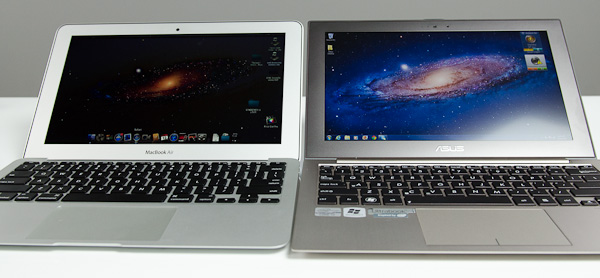
2012 MacBook Air (left) vs. 2012 ASUS Zenbook Prime (right)
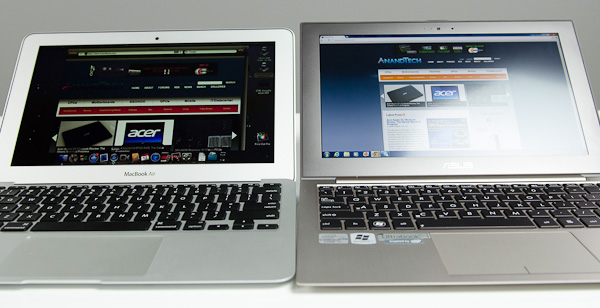
2012 MacBook Air (left) vs. 2012 ASUS Zenbook Prime (right)
ASUS also enjoys a resolution advantage, but it's not really high enough to make good use of integer DPI scaling (at 2x you get a UI sized for a 960 x 540 display). You get sharpness, and additional desktop area, but not the total package you get with the rMBP. There's no denying that what ASUS has done is better, it's just not perfect. And as Apple has shown us in the past, it's not fond of stopgap solutions.
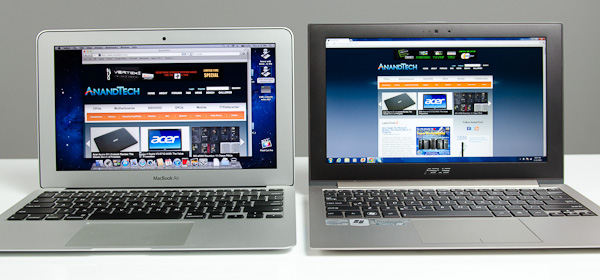
2012 MacBook Air (left) vs. 2012 ASUS Zenbook Prime (right)
Brightness, black levels, contrast, color accuracy and gamut haven't changed over the past year. The MacBook Air's panel remains one of the best non-IPS solutions on the market. The problem is that consumer insistence higher quality displays has pushed Apple's competitors to finally deliver more than TN at MacBook Air price points. Sooner rather than later, Apple will have to respond.
The Panel Lottery
Unlike in previous years, there appears to be three manufacturers supplying panels for the 2012 MacBook Air. LG Philips and Samsung return from before, but AUO now joins the fray. It's quite possible that Apple's volumes have grown large enough to justify adding a third supplier - a trend we may see increase in the future, and across more component categories.
As always, you can try to find out what panel is used in your MacBook Air by executing the following command in an OS X Terminal window:
ioreg -lw0 | grep IODisplayEDID | sed "/[^<]*</s///" | xxd -p -r | strings -6
The output will look something like this:

As long as Apple hasn't masked the data, the first line should be the part number of your display panel. The first one or two characters will tell you the manufacturer: LP for LG Philips, LT for Samsung and B for AUO. Anecdotally, LG and Samsung seem to be the most prevalent. In my personal experience with six 13-inch 2012 MacBook Airs and three 11-inch MacBook Airs, the breakdown was as follows:
13-inch $1499 - Samsung
13-inch $1499 - Samsung
13-inch $1499 - Samsung
13-inch $1499 - Samsung
13-inch $1499 - Samsung
13-inch $2199 - LG
11-inch $1099 - AUO
11-inch $1099 - AUO
11-inch $999 - Samsung
A thread over on Macrumors places the Samsung/LG split much closer to 50/50, however it's not clear if there's a higher incidence of LG panels in BTO or non-default configurations. We'd need many more samples to really get an idea for how all of this shapes up, so don't put too much faith in the results from my experience.
Apple does its best to ensure that all three panels deliver comparable performance, however there are differences. Let's first start with the numbers:
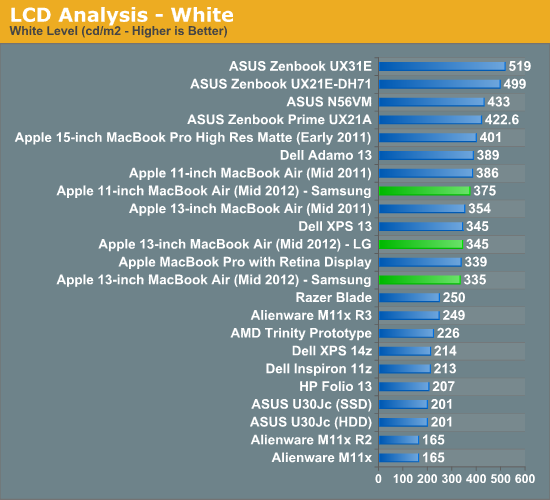
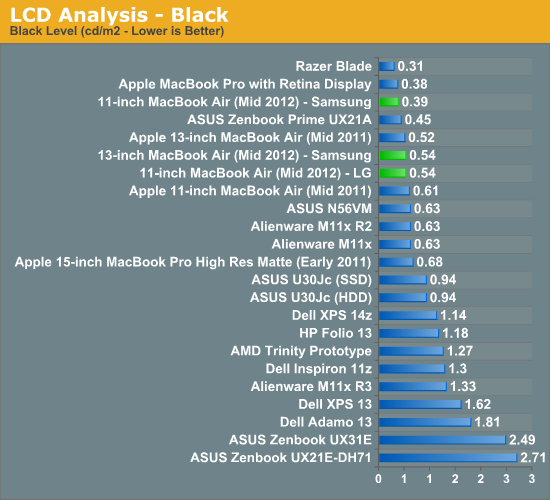
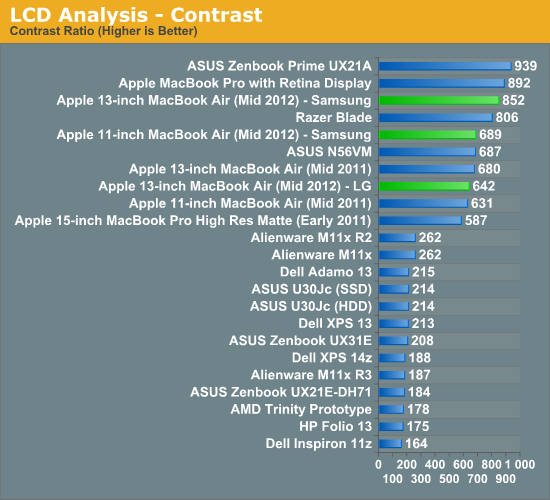
The 13-inch LG panel delivers tangibly worse black levels than the Samsung alternative. There's even a pretty dramatic difference in black levels between even the 11 and 13-inch Samsung panels. It's also possible that there's panel to panel variation at play here that would result in this sort of a difference.
The LG panel is a bit brighter, which helps it reach a decent contrast ratio but the 13-inch Samsung panel's low black levels give it an advantage. Interestingly enough, the 13-inch LG sample performed very similarly to the 11-inch Samsung. I really do wonder how much of this difference is just normal variance between panels.
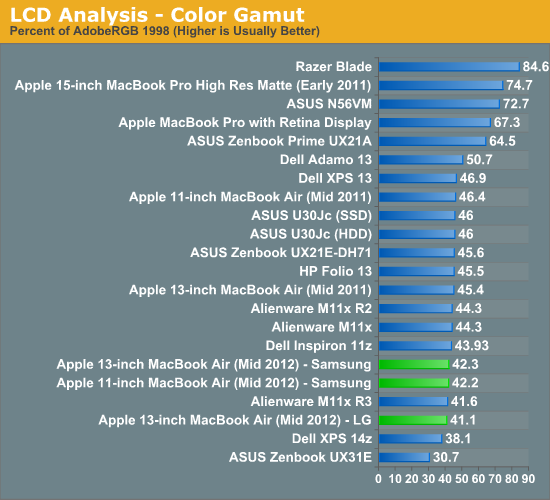
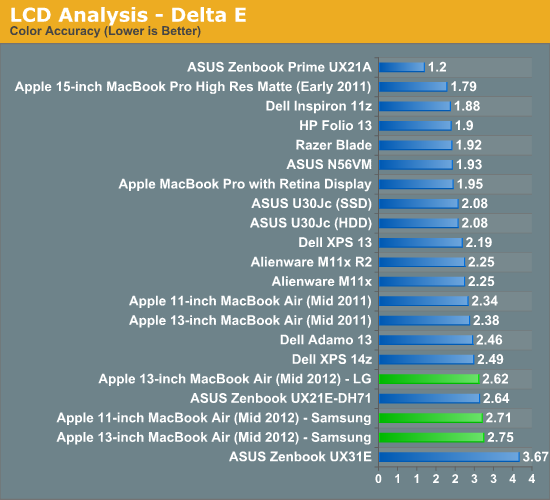
Color accuracy is slightly better on the LG panel, although it's not beyond the noticeable threshold. Color gamut is comparable between the displays.
Independently, neither the Samsung or LG panels is particularly bad to look at. These are still TN panels so you get poor vertical viewing angles, but the quality is still better than the cheaper TNs we often see used in less expensive notebooks. It's when you compare the two or you're used to one that you can really tell a difference: the Samsung panel, particularly when displaying black text on a white background, looks better than the LG.
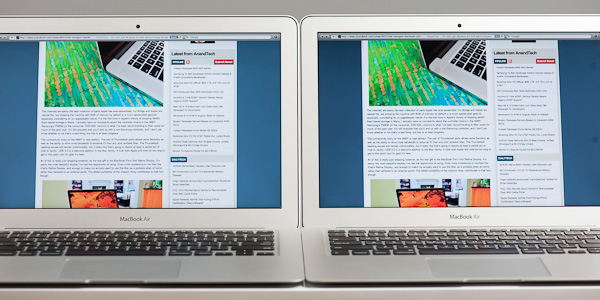
13-inch LG LP133WP1-TJA3 panel (left) vs. Samsung LTH133BT01A03 panel (right)
I had some friends over and tossed them a pair of 13-inch MBAs. One had the LG panel and one had the Samsung panel. They used the MBAs and swapped after a short while. Almost instantaneously they could tell the difference between the panels. Everyone significantly favored the Samsung.
I was actually a bit surprised how quickly they noticed the difference. With these type of things I always assume I'm just more sensitive than most, but in this case the difference was noticeable enough to pick out. Everyone added (and I agreed) that the difference was most pronounced because they were able to switch between two. In a vacuum each one seemed fine.
I tried my best to capture the difference between the two panels on camera. The easiest way to describe the difference is text on the Samsung panel just looks darker (mouse over the panel name in the table below):
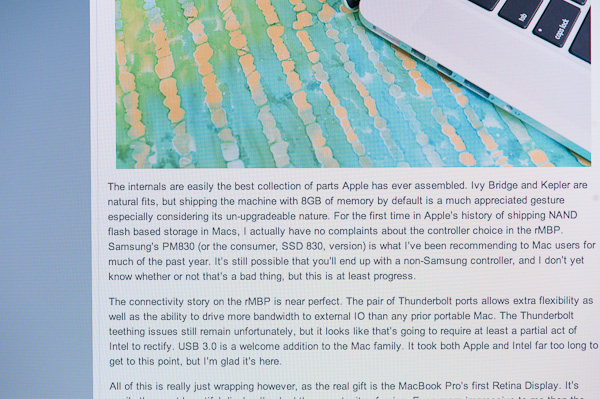
| LG LP133WP1-TJA3 | Samsung LTH133BT01A03 |
| original | original |
Just like last time, I believe the two panels behave differently in how they react to off-center viewing angles but I couldn't really capture the slight differences on camera. Although I didn't have an AUO equipped MBA on hand, the one I saw in an Apple store looked closer to the LG than the Samsung.
The good news is after a calibration pass using Color Eyes Display Pro, the difference between the two is significantly reduced - to the point where I can no longer tell the two apart:
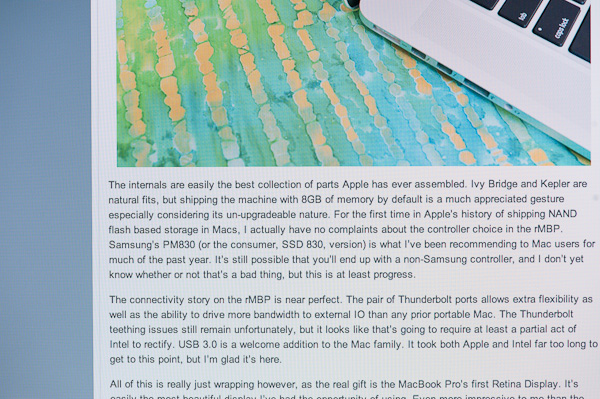
| LG LP133WP1-TJA3 | Samsung LTH133BT01A03 |
| original | original |
The obvious problem with this solution is you need access to a decent colorimeter or spectrophotometer and calibration software. There are some color profiles floating around the web that may help (I've uploaded mine for the LG here, Samsung here) but every panel is going to be at least somewhat different so this is still not perfect.
Subjectively, I'm fine with the LG panel, although I do like the look of the Samsung better. Both are a bit of a disappointment compared to what you get from the Retina Display in the MacBook Pro however. It's just presently what you give up for portability and cost.
To Make a Retina
The thing about the MacBook Air is that it's already quite minimized on the inside. The vast majority of the chassis is occupied by a battery, and there's no traditional HDD or optical drive to remove for additional space. Apple can't simply toss a much higher resolution panel on the system and call it a day, at least not without a tangible reduction in battery life.

13-inch MacBook Air (Mid 2012) - iFixit
Apple had to give the MacBook Pro with Retina Display a 95Wh battery (up from 77.5Wh) just to deliver similar battery life to the regular MacBook Pro. The higher resolution display requires a brighter backlight to push light through the panel and maintain comparable brightness levels.
The motherboard itself can stand to lose a single chip (the PCH) with the transition to Haswell, but that's not going to give us a ton of space either.
In the short term Apple could opt for a slightly thicker chassis (similar to what happened in the 3rd gen iPad) to accommodate a larger battery. Eventually the hope is that panel efficiency will increase to the point where we won't need significantly brighter backlights.


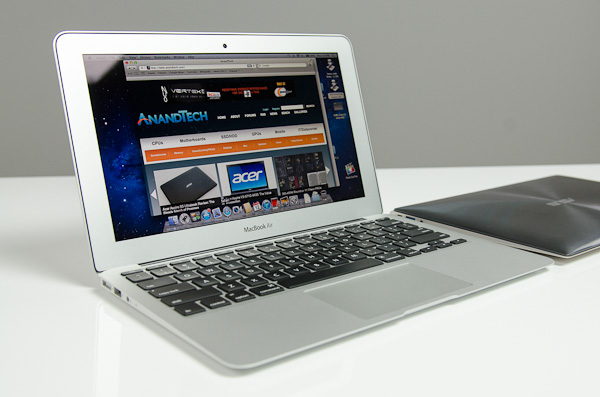








190 Comments
View All Comments
Pneumothorax - Monday, July 16, 2012 - link
The only way some of the anti-apple fanbois here are going to be placated is if you filled the review with "This laptop is too expensive" "All the other PC ultrabooks including Acer is better" "Don't drink the Apple kool-aid"As a Win7/OSX user myself, I find your reviews to be the most fair and thorough in reviewing Apple products. The earlier rMBP/MBA reviews by others seemed to just read as a re-written Apple press-release.
PS Your rMBP review finally convinced me to get the rMBP, so you could be an Apple shill after all lol.
ananduser - Monday, July 16, 2012 - link
How do you like it so far ?Is 3rd party compatibility an issue with the large panel ?
Have you noticed the UI lag(from the review) when you're mulitasking ?
Does it really get that hot ?
Pneumothorax - Monday, July 16, 2012 - link
Best laptop I've owned and I've had Alienware, Dell, Asus, Lenovo, and the worst - HP. The panel still has teething issues with MS office and lightroom/CS5. The lag is there, but the screen is so good it's overlooked. Tried a buddy's rMBP that has the golden master Mountain Lion installed on it and it's much much smoother than Lion. Mountain lion is to Lion like Win7 was to Vista. Lion is a slow/memory hog.Heatwise, it's much cooler and QUIETER than my 2011 MBP 15. D3 on my 2011 MBP would remind me of Delta CPU fans on prescott CPU ages ago, D3 on my rMBP = fans barely audible.
KoolAidMan1 - Monday, July 16, 2012 - link
Sounds like you're angry because of your own personal biasLepton87 - Tuesday, July 17, 2012 - link
Sadly, I must agree. Lines like that"There's no denying that what ASUS has done is better, it's just not perfect. And as Apple has shown us in the past, it's not fond of stopgap solutions."
Seriously? 200dpi on a 11'' screen is a stopgap solution?
I'm never reading an apple review made by anand again.
KPOM - Tuesday, July 17, 2012 - link
What he means is that Apple likely won't change the screen resolution until they can quadruple it (2880x1800 on the 13.3" and 2732x1536 on the 11.6"). If they go with straight 1080p on the 13" or 11" as ASUS is doing, they would likely have to use a 1.5x scaling option to avoid small text. That isn't something that Apple is likely to do in OS X. So yes, it would be stop gap for Apple, even though it might not be a stop gap for ASUS.Freakie - Tuesday, July 17, 2012 - link
I agree with you De_Com. While Anand still adheres to relatively object testing methods, there is no doubt that the tone throughout any of these Apple products reviews clearly shows Anand's personal opinion towards Apple products. It is a bit disconcerting to come to Anandtech and have just this one little niche seemingly out of place in the large supply of amazing reviews. Thankfully it doesn't happen very often, but it does feel like it totally goes against the grain of all of the other Anandtech reviews.And I echo that I would love to see one of the other writers do one of these Apple reviews. It does seem odd that Anand is always the reviewer, when other reviewers mention owning Apple products and would seem to be able to have the ability to compare Apples to Apples just fine, as well as the rest of the market.
But in the end, this IS Anand's website, and I of course still respect him and the website he has built and while I may not agree with every part of it, I also do not understand every part of him and his opinions and decisions so there very well could just be something that we are missing from our own opinions on the matter.
De_Com - Tuesday, July 17, 2012 - link
Nice to see my comment sparked a bit of lively debate, although I did know I'd get one or two thoughtless responses i.e "oh these Apple haters" or "but it's cool to bash Apple", EnzoFX and Kpom I'm looking at you !Also nice to see Anand respond as well.
I believe Sunburn74 said it best when he likened our subconscious wish not to dismiss or deconstruct the things we use ourselves as it somehow goes against our own wishes.
It was nice to see others also call for another reviewer to be given a crack at an Apple Notebook.
One more thing :- Love the site, Love the reviews, keep it up Anand.
KPOM - Friday, July 20, 2012 - link
Thoughtless response? That describes you a lot more than me. Also, in case you didn't notice, Anand did NOT review the new non-Retina MacBook Pro.phillyry - Tuesday, March 26, 2013 - link
Precisely because he didn't care about the non-retina 15" MBP (that's my conclusion anyways).I mean, if you were the head of this website wouldn't you choose to do the reviews that you actually cared about?
I think Anand's been pretty clear about his preference for MacBooks and his absolute obsession with SSDs. Why wouldn't he have a preference (or bias, if you must) for the best excited hardware, with software that he likes, that's going in the direction that he thinks is the future of the notebook industry, namely small form factor ultraportables based on SSDs.
I really don't see the fuss and actually enjoy seeing Anand enjoy doing his work (writing reviews).
It would be nice if people could move past the fanboism debate that rages across the Internet nd just discuss the points made in the review and, imagine this, even the device itself!